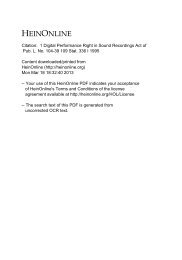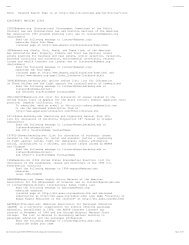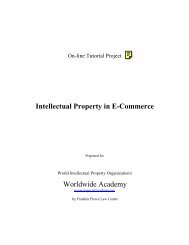BIEDERMANN MOTECH GMBH and Depuy Spine, Inc, Plaintiffs
BIEDERMANN MOTECH GMBH and Depuy Spine, Inc, Plaintiffs
BIEDERMANN MOTECH GMBH and Depuy Spine, Inc, Plaintiffs
You also want an ePaper? Increase the reach of your titles
YUMPU automatically turns print PDFs into web optimized ePapers that Google loves.
application was filed, could have relied on his background knowledge <strong>and</strong> the results of routine<br />
experimentation to practice each variation. Liebel-Flarsheim Co. v. Medrad, <strong>Inc</strong>., No. 06-1145, slip op. at<br />
10-15 (Fed.Cir. Mar. 22, 2007) (precedential). The written description requirement m<strong>and</strong>ates that an<br />
inventor provide enough detail in the patent application to show that, at the time of filing the patent<br />
application, the inventor actually had in mind what is later purported to be the invention. Gentry Gallery,<br />
<strong>Inc</strong>. v. Berkline Corp., 134 F.3d 1473, 1479 (Fed.Cir.1998). It is true that the Federal Circuit has cautioned<br />
against over-reliance on the validity-preserving principle of claim construction. If the intended meaning of<br />
the claim language is clear, such as from reading the prosecution history of amendments made to claims or<br />
from analyzing claim differentiation, then applying the principle of preserving claim validity to reach a<br />
different claim construction amounts to "judicial rewriting of claims to preserve validity," which is<br />
forbidden. Liebel-Flarsheim Co. v. Medrad, <strong>Inc</strong>., 358 F.3d 898, 910-12 (Fed.Cir.2004). That said, it is<br />
acceptable to use this tool if the claim language is ambiguous. Id.<br />
Phillips also instructs that prosecution history, or the statements made by the inventors to the patent office,<br />
is crucial for the Court to consider in claim construction. Phillips, 415 F.3d at 1317. At times the prosecution<br />
history may be less clear than the specification. Id. at 1317. Yet if the inventors made remarks to the<br />
examiner that limited the scope of their invention, the claims must be constructed in a narrower way which<br />
accords with their remarks. Id. See also Amhil Enters. v. Wawa, <strong>Inc</strong>., 81 F.3d 1554, 1559-62 (Fed.Cir.1996).<br />
Indeed, the very purpose of consulting the prosecution history is to exclude any interpretation that the<br />
inventors disclaimed during prosecution. Phillips, 415 F.3d at 1317.<br />
Additionally, the Court can rely on extrinsic evidence, such as dictionaries <strong>and</strong> treatises, at any time to give<br />
context to the meaning of words. Id. at 1317-18, 1324. The Court will not rely on dictionaries or treatises<br />
for interpretations which are inconsistent with the claims, specification, or prosecution history because<br />
"there is a virtually unbounded universe of potential extrinsic evidence of some marginal relevance that can<br />
be brought to bear on any claim construction question. In the course of litigation, each party will naturally<br />
choose the pieces of extrinsic evidence most favorable to its cause." Id. at 1319-20.<br />
It is frequently the case that a patent is litigated in several consecutive cases against different defendants.<br />
Therefore, it is not unusual for a court to be asked to interpret a claim term which was previously<br />
constructed by another court, either another district court or the Federal Circuit. Both situations present<br />
themselves in this case. Previous claim constructions of the same patent by other courts can be "highly<br />
persuasive" in analyzing patent claims. Kemin Foods, L.C. v. Pigmentos Vegetalesdel Centro S.A. de C.V.,<br />
319 F.Supp.2d 939, 941-42 (S.D.la.2004). If the same issue arises in a future case, the Federal Circuit's<br />
ruling is dispositive, as claim construction is a matter of law. See Markman v. Westview Instruments, <strong>Inc</strong>.,<br />
517 U.S. 370, 391, 116 S.Ct. 1384, 134 L.Ed.2d 577 (1996); Cybor Corp. v. FAS Techs., 138 F.3d 1448,<br />
1455 (Fed.Cir.1998) (en banc). It is important, however, to recognize that claim construction orders are<br />
narrowly tailored to assist the jury in resolving infringement <strong>and</strong> validity disputes in particular cases. It is a<br />
mistake to treat even definitions from the Federal Circuit as eternal <strong>and</strong> universal truth, suitable for use in<br />
any future dispute. It may be that a prior interpretation by the Federal Circuit needs to be tweaked,<br />
remaining consistent with the original definition, to resolve a dispute in another case.<br />
IV. CLAIM CONSTRUCTION ANALYSIS<br />
<strong>Plaintiffs</strong> have requested that the Court interpret the phrases "two holes for receiving a rod," "spherically<br />
shaped portion," "compression member," <strong>and</strong> "for exerting a force onto said head, such that said head is<br />
pressed against the hollow spherically shaped portion." Allez would instead ask the Court to interpret the






